
Science in Hinduism - Speed of light
In your school days, you must have studied that light travels at a speed of 3 x 10^8 metres/sec. We are taught that speed of light (299,792 ,58metres/s) was discovered in 1695 by a scientist named Ole Roemer and later proved by many experiments, including the experiment conducted by American Physicists Michelson and Morley in the early 19th Century. Though different physicists tried to measure the speed of light through different experiments, the first successful attempt to measure the speed of light was performed by Max Planck. This is what we are taught in schools but unfortunately, we are not taught that measuring the speed of light was a very old phenomenon and the first estimate of the speed of light was given by Vedic scholars thousands of years ago.
Check the below video for graphical explanation of this article
Why Vedic scholar derived speed of light?
Worshipping sun or Surya Dev has been going on in India since time immemorial. Even today, many of the traditional festivals like Pongal, Chatth puja and yoga forms like surya namaskar are venerated to either worship sun god or pay respect to Sun god (Surya).
In rig veda, there are many verses dedicated to sun god. For example, the below verse defines the properties of light
“Seven horses draw the chariot of the sun, tied by snakes”. Rig Veda 5.45.9
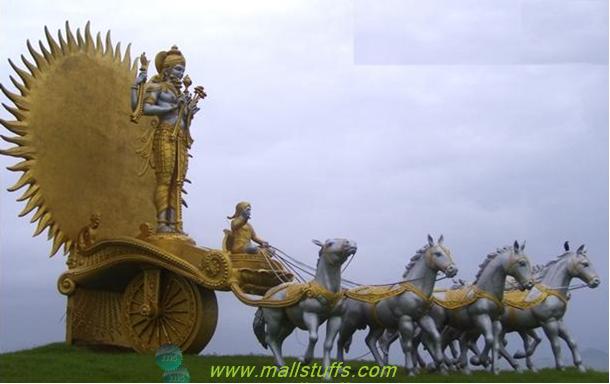
Sun god and its seven horses
If you are smart then you must have understood what this allegory means. Seven horses refer to nature of light as being composed of 7 colors and “tied by snakes” symbolizes the curved path of this light. Examples are rainbow and lights refracting from prism. These seven colors are mentioned in Vedic sutras and referred in modern science as red, orange, yellow, green, blue, Indigo and violet. These seven colors were unknown to western world till 17th century when Sir Issac Newton copied the theory of gravitational force and properties of light from Indian scriptures.
Science in Hinduism-Gravitational force and repulsive force
Speed of light in Vedic scriptures
One verse from rigveda explicitly defines the speed of light.
“Yojananam Dwe Dwe Shate Dwe Cha Yojane
Aken Nimishardhena Krammana Namostute” (Rig-veda book I, chapter 50, hymn 4)
Dwe means “two”, shate means “Hundred”, Nimishardhena means Half Nimisha. So the above verse in English translates as
“Sun light travels 2202 Yojanas in half Nimisha.”
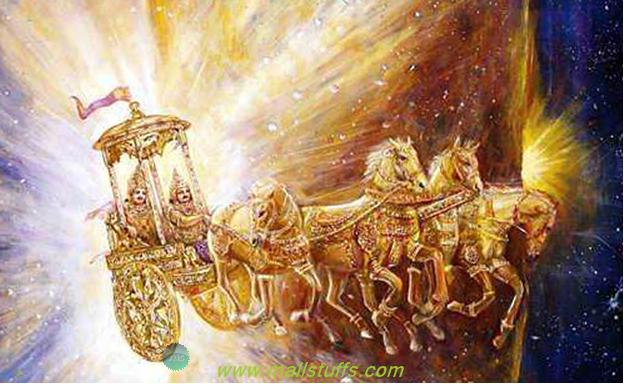
Rays of light emanating from sun
Now you may wonder what the heck is ‘yojana’ and ‘Nimisha’. In Vedic terminology, yojana and Nimisha is Vedic unit of distance and time respectively. That’s ok but how these Vedic units are expressed in modern SI units. Well, this is the most difficult part. Since rigveda is a book of hymns dedicated to god, it does not have any definition of yojana or nimisha. Also, since yojana and nimisha were the most common units used in those times, many of the books written in that era didn’t explicitly defined yojana and nimisha. However, we have many other ancient books that define the measurement of yojana and nimisha.
Measurement of Nimesa in SI units
Nimisha in Sanskrit means winking the eye or something that happens within the blink of an eye. Nimishardhena means half of nimesa. According to science, our eyes can blink five times in one second. So, as per modern science, Nimishardhena is 0.1 seconds.

Our beautiful eyes can blink five times per seconds
Nimisha is described in shanti parva of Mahabharata (World longest epic poem) as:
1 Diva-Ratri(Day & Night)=30 Muhurtas (1 hr= 1.25 Muhurtas)
1 Muhurta=30.3 Kala (1 hr= 1.25 *30.3= 37.87 Kala)
1 Kala =30 Kashta (1 hr= 37.87 *30= 1136.25 Kashta)
1 Kastha=15 Nimisha (1 hr= 1136.25 *15= 17043.75 Nimisha)
Now that 1 hr is equal to 17043.75 Nimisha, 1 nimisha is equal to 60*60/17043.75= 0.2112 seconds. Hence, 1/2 Nimisha = 0.1056 seconds (Remarkably closer to scientific derived value of 0.1 seconds).
Modern scholars have derived the value of nimisha as 16/75 seconds. Hence ½ nimisha according to such scholars is .1066
Measurement of Yojana in SI units
Yojana is described in detail in ancient vedic text Vishnu purana (Book 1, Chapter 6).
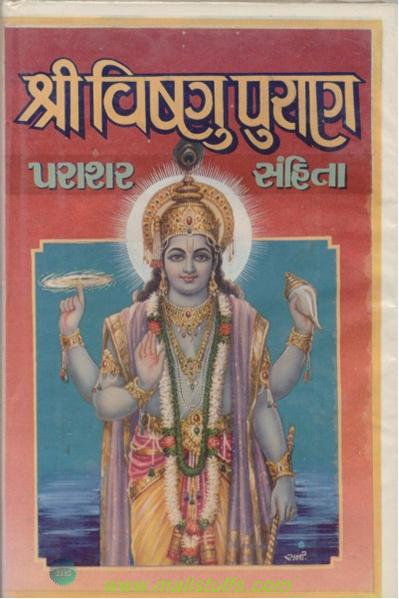
Yojana can be expressed in other vedic units as shown below
10 Paramáńus = 1 Parasúkshma
10 Parasúkshmas = 1 Trasareńu
10 Trasareńus = 1 Mahírajas (particle of dust)
10 Mahírajasas = 1 B ál ágra (hair’s point)
10 Bál ágras = 1 Likhyá
10 Likhy ás= 1 Y úka
1o Y úkas = 1 Yavodara (heart of barley)
10 Yavodaras = 1 Yava (barley grain of middle size)
10 Yava = 1 Angula (finger, or inch)
6 fingers = 1 Pada (the breadth of it)
2 Padas = 1 Vitasti (span)
2 Vitasti = 1 Hasta (cubit)
1 Yojana= 4 Gavyutis(distance till the cow ‘’MOOOOW” is heard)=4*12000 feet=4*3.6576=14.46 km~9 miles
1 Yojana =8000 Dhanus or Purushu(man’s height)= 8000* 6 feet=14.63 km
Note that I have used the approximate value for all conversion. For example, I have assumed the man’s average height a 6 feet. In paper published in Indian Journal of history of science, sir Monier Williams based on his research, derived the value of yojana as 9 miles. Further aryabhatta defined angula as between 1.8 and 1.9 cm. Hence yojana between 14.6 and 16.4 km
Calculation of speed of light:
Now that we have the value of yojana and nimisha, we can calculate the speed of light in modern SI unit as
= 2202 x 9 miles/ 0.1056 seconds
= 19818/0.1056 seconds
= 187670.45 miles per second
Modern accepted value of speed of light in miles per second is 186000 miles/second, very close to the above derived value.
Some more evidences and calculations
Kautilya’s Arthashastra, written in 320 BC, defines 1 nimesha as 1/360,000th of a day and night ~ i.e. 0.24 seconds. Hence half of nimisha according to Kautilya’s Arthashastra is 0.12 seconds.
If you measure the cubit (Hasta) of all ancient civilization, you will find it to be between 50 and 53 cm. Sacred Egyptian cubit measures 52.92 cm. Sacred Babylonian cubits measured 51.03 cm. Egyptian royal cubit measures 52.3881 cm. Copper bar excavated from Nippur (c. 2650 BC) defined Sumerian cubit as 51.85 cm. Persian cubit measures about 50.01 cm. Harappan cubits were between 51.562 cm and 52.324 cm. Based on cubit calculation, yojana is calculated to be between 16.20 and to 16.74 km.
Persian purusha were about 2.0004 m tall while copper man of Nippur 2.074 m tall. Purusha in Indus valley were about 2.062 and 2.093 m tall. Based on purusha calculation, yojana again comes out to be between 16.50 km and 16.74 km
Considering the above yojana measurements as true and the calculation of nimisha mentioned in Kautilya’s Arthashastra to be true, we can derive the speed of light between 297270 and 307179 km/sec, a good range to modern accepted sped of light (299792 km/sec)
Commentary on speed of light by sayana
Sayana, a scholar par excellence and minister in court of Vijayanagar Empire of Karnataka (early 14 century) in his commentary book on rigveda said

The above translates into:
"Also it is to be remembered that the Light due to the Sun travels 2202 Yojanas in half a Nimesha"
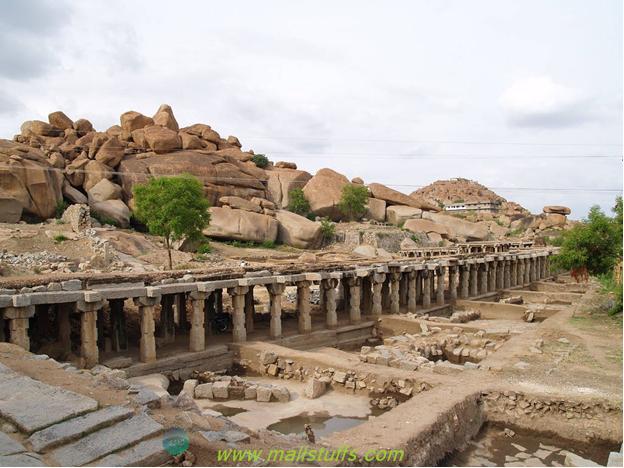
Remains of Vijayanagar Empire at hampi
He further added “sun giving light to all things, even to the moon and the planets, by night; for they are of a watery substance from which the rays of the sun are reflected.”
Above comment of sayana seems to be derived from the following verse of rigveda
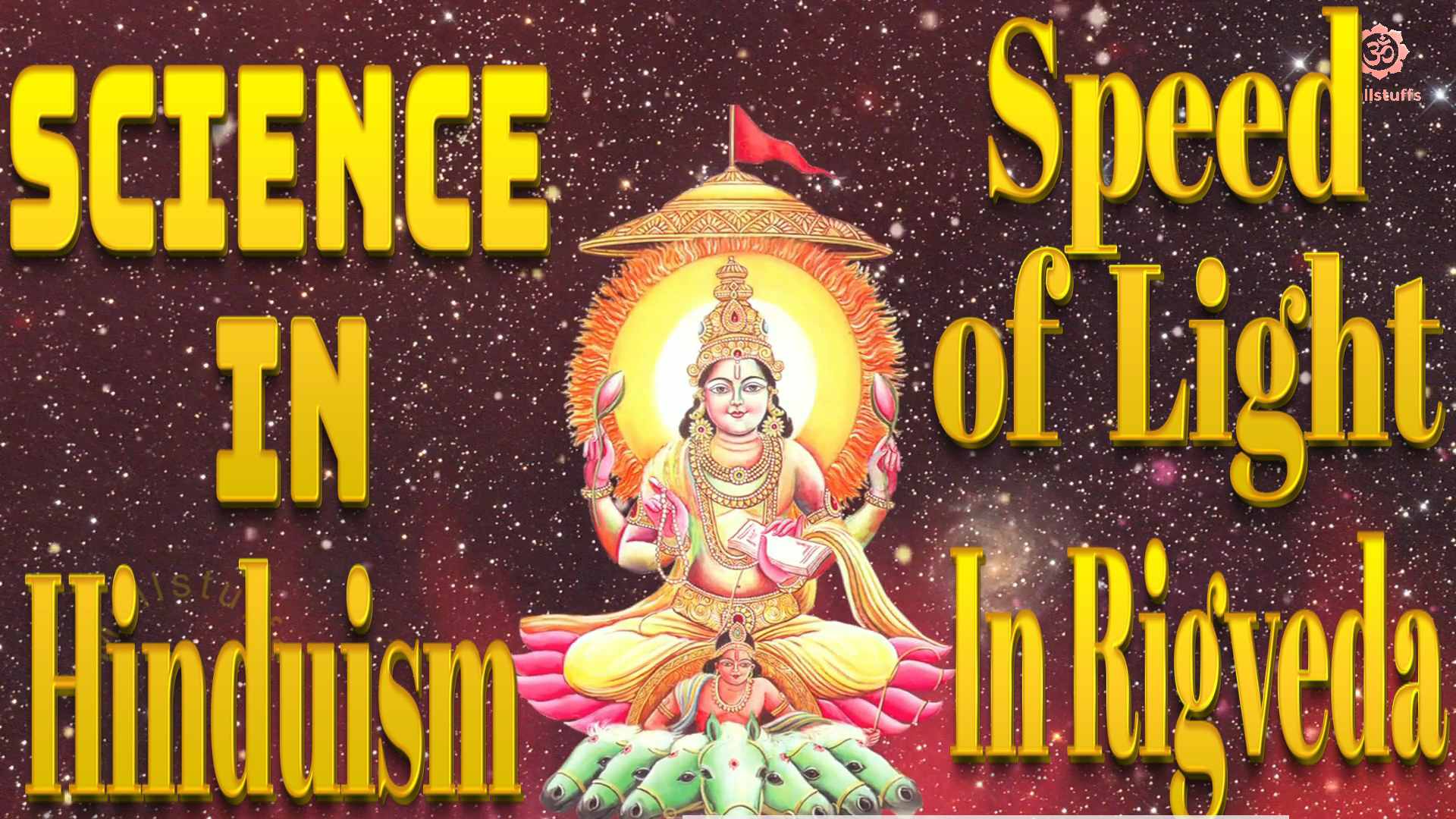
This verse is translated as
“Swift and all beautiful art thou, O Surya (Surya=Sun), maker of the light, Illuming the entire radiant realm.”
Since Sayanacharya was only commenting on the Rig Vedic text, it is practically possible that even in earlier times, many interpretation and translation of various measurements existed, but were lost due to the burning of world most ancient universities situated in india like Nalanada and taxila, by the cruel British and mughal invaders.
Why this minute error is ignorable
Hence, considering all the possible error in translating Vedic unit to SI units plus the various possible values of yojana and nimisha, Vedic speed of light comes out to be between 268270 and 307179 km/sec
Above minor difference can be attributed to the following reasons:
1) We don’t have precise definition of yojana or nimisha. Hence, we can derive only its closest possible value.
2) Even a small error makes a big difference when multiplied/divided by a huge number/small number. Hence, when expressed in thousands of miles or kilometers, there will be considerable difference in value.
Hinduism-Scientifically proven
Conclusion:
Hence, I don’t have a slightest doubt that the Vedic sages were aware of speed of light since all their other theories matches with modern science. We should be appreciating the ancient Vedic knowledge which dates back to thousands of years. Ancient Vedic Indians has established the speed of light many milleniums ago before all the western modern scientists. Western science took at least three millenniums to come close to Vedic estimate of speed of light. This once again proves the scientific knowledge of Ancient India.
Note: Images used on this website
are either a production of Bhaktivedanta Book Trust(https://www.krishna.com), Iskcon
Foundation or were found in google search under "Free to use and share". If any
of the images presented here violates copyright issues or infringes anyone copyright
or are not under "Fair use", then please bring it to our notice. Read
Disclaimer for more.
Share this to your friends. One of your friend is
waiting for your share.
Related Articles
Why Kumbh Mela is celebrated
Is Goddess Durga the supreme universal mother
Chhath Puja - World oldest festival dedicated to sun god
Bhagavad gita Chapter 1,verse 1 english and hindi poetic translation with learnings
Stories behind celebration of dhanteras
How to chant AUM and mantras
Interstellar travel and aerial flying chariots-Part 1
Science in Hinduism-Creation of Humans and third type of lord vishnu
Ill effects of caste system
Hinduism greatness quotes by famous philosophers and scientists
Post Comment